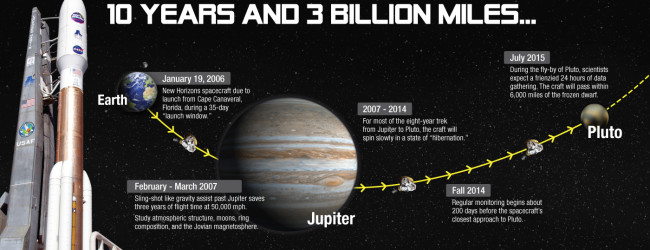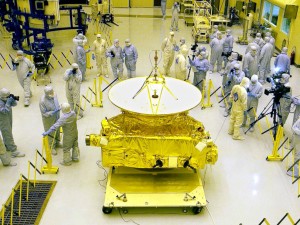
By Prof. Nidhal Guessoum
 On July 14, Nasa spacecraft New Horizons will be passing by Pluto at the astronomically “very close” distance of 13,000km. It will have travelled 4.8 billion km, for over nine years, at the speed of 50,000 km/hr. Launched in January 2006, it took one year to pass by Jupiter and another 8.5 years to reach Pluto. This last new world will finally be revealed to us through hundreds of photographs.
On July 14, Nasa spacecraft New Horizons will be passing by Pluto at the astronomically “very close” distance of 13,000km. It will have travelled 4.8 billion km, for over nine years, at the speed of 50,000 km/hr. Launched in January 2006, it took one year to pass by Jupiter and another 8.5 years to reach Pluto. This last new world will finally be revealed to us through hundreds of photographs.
Indeed, we have not had a spacecraft photograph a planet up close for the first time in more than 25 years, when the two Voyager probes passed by the giant planets and sent back fascinating photos. And so the excitement over this event has been building for the last several months, if not years, among all cosmos enthusiasts, from professional astronomers to pupils.
Pluto has always been a favourite with children and students because of its tiny size, because it was only discovered in 1930 and because it was named by an 11-year-old English girl (after the Roman god of the underworld). But Pluto became a truly beloved object in 2006, when it was downgraded from “ninth planet” to “dwarf planet” (based on a controversial new definition of “planet” that Pluto did not fulfil). To this day, protests are voiced or written, even by some professional astronomers.
Pluto had always been a peculiar “planet”. It does revolve around the Sun, but with a very inclined orbit, it is incredibly small (10,000 times smaller than its nearest neighbour Neptune, 175 times smaller than Earth and almost four times smaller than our moon!). Located beyond the giant planets, it sometimes crosses the orbit of Neptune and it rotates backward (the Sun rises from the West on Pluto, once a week or so) … Oh, and it is incredibly cold: Temperatures on its surface range from 220 to 380 degrees below zero-degree celsius!
The dwarf planet is so small that even our best and most powerful telescopes can only give us a fuzzy picture, barely showing some redness. No surface features have ever been imaged. We do know that it is made of ice and dirt, for its density is closer to that of ice than to that of solid rock. And we do know that it has a very thin but huge atmosphere of nitrogen. All this we can figure by analysing the tiny amount of light that reaches it from the Sun and gets reflected toward us (and our telescopes and instruments).
In fact, we know that Pluto is a “binary” planetary system, since its “moon” Charon has only one sixth of Pluto’s mass (by comparison, our “big” moon has 1/80th the mass of Earth), so Pluto and Charon dance around each other, or rather around a spot in between them. Not only that, but this couple has four little kids, tiny moons that play around their “parents”. And New Horizons could find that the family is larger still …
The spacecraft has indeed started to reveal some fascinating features of Pluto, even though it is, as I write, several million kilometres from the icy world. The cameras onboard New Horizons have shown dark streaks near the dwarf planet’s equator, and while we await sharper images in the coming days, speculation is afoot about the nature of those streaks: Organic molecules spewed by geysers from under the surface? If so, when did those eruptions take place, recently? That would be fantastic …
What else can we expect to learn from the images and data that New Horizons will send back to us from its passing encounter with Pluto and Charon? Indeed, why did we bother to send a spacecraft to the outskirts of the solar system where this tiny, apparently insignificant icy rock orbits the sun at some five billion km … once every 248 years?!
My usual reply to the last question is “because it’s there” (George Mallory’s sublime reply about the reason to climb Mount Everest). My more scientific reply is that Pluto carries features reminiscent of early Earth: It may still have lots of craters from the many collisions during the early, hectic era of the solar system, but it is losing its primitive atmosphere just like Earth lost its hydrogen atmosphere early on. Its “moon” Charon was produced from a giant impact, just like our moon was; its past (and possibly present) geological activity could reveal interesting underground mechanisms; etc.
What is certain is that everyone will be marvelling at and analysing photos from Pluto and its “family” for months, as the spacecraft, with its limited bandwidth, will have to send its photos over several months.
It is not often that we humans get the chance to discover a new world, to experience surprise, new beauty and awe. We must savour this moment in our collective history. This is for humanity altogether, for experts and laymen alike, for old and young minds. I hope children and students will be tuned today for the pictures and comments that will be shared.
I wish New Horizons the best of success today and in its future, as it moves towards the region of comets, where perhaps it will send us some unexpected discoveries. And on behalf of all humanity, I thank the thousands of men and women who have helped make this historic day.
Nidhal Guessoum is a professor of physics and astronomy at the American University of Sharjah. You can follow him on Twitter at: www.twitter.com/@NidhalGuessoum.
Originally published at: http://gulfnews.com/opinion/thinkers/pluto-the-last-new-world-at-last-1.1549634